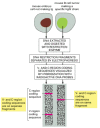Sunday, 7 December 2014
Antibody Diversity
Sunday, 7 December 2014 by Unknown
The Generation of Antibody Diversity
Even in the absence of antigen stimulation, a human can probably make more than 1012 different antibody molecules—its preimmune antibody repertoire. Moreover, the antigen-binding sites of many antibodies can cross-react with a variety of related but different antigenic determinants, making the antibody defense force even more formidable. The preimmune repertoire is apparently large enough to ensure that there will be an antigen-binding site to fit almost any potential antigenic determinant, albeit with low affinity. After repeated stimulation by antigen, B cells can make antibodies that bind their antigen with much higher affinity—a process called affinity maturation. Thus, antigen stimulation greatly increases the antibody arsenal.
Antibodies are proteins, and proteins are encoded by genes. Antibody diversity therefore poses a special genetic problem: how can an animal make more antibodies than there are genes in its genome? (The human genome, for example, contains fewer than 50,000 genes.) This problem is not quite as formidable as it might first appear. Recall that the variable regions of both the light and heavy chains of antibodies usually form the antigen-binding site. Thus, an animal with 1000 genes encoding light chains and 1000 genes encoding heavy chains could, in principle, combine their products in 1000 × 1000 different ways to make 106 different antigen-binding sites (although, in reality, not every light chain can combine with every heavy chain to make an antigen-binding site). Nonetheless, the mammalian immune system has evolved unique genetic mechanisms that enable it to generate an almost unlimited number of different light and heavy chains in a remarkably economical way, by joining separate gene segments together before they are transcribed. Birds and fish use very different strategies for diversifying antibodies, and even sheep and rabbits use somewhat different strategies from mice and humans. We shall confine our discussion to the mechanisms used by mice and humans.

We begin this section by discussing the mechanisms that B cells use to produce antibodies with an enormous diversity of antigen-binding sites. We then consider how a B cell can alter the tail region of the antibody it makes, while keeping the antigen-binding site unchanged. This ability allows the B cell to switch from making membrane-bound antibody to making secreted antibody, or from making one class of antibody to making another, all without changing the antigen-specificity of the antibody
Subscribe to:
Post Comments (Atom)


0 Responses to “Antibody Diversity”
Post a Comment